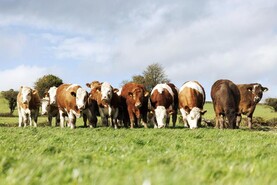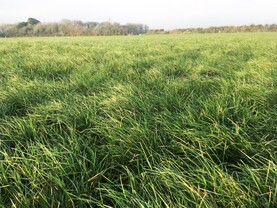To prevent silage clamp slippage, it is necessary to ensure that every load of grass is properly consolidated at ensiling, a leading silage expert has advised.
Conducting an online workshop organised by AHDB, Dr Dave Davies, who runs his own consultancy firm, Silage Solutions Ltd, told farmers an inconsistent density of silage within a clamp is the most likely cause of slippage.
When it happens, it greatly increases losses, and significantly reduces the quality of silage fed to livestock. It is a problem that has been reported by more farmers in recent years.
Only two farms had increasing density as you went down the clamp
In a study of the issue, Davies assessed 10 silage clamps that had slipped, and found that in seven of these clamps, inconsistent density was the major issue.
“Only two farms had increasing density as you went down the clamp – all the others had regions in the clamp where there were differences, with denser silage sitting on top of less dense material”.
He believes that over time this lower density material will start to bulge, and then eventually slip.
In his study, the clamps were larger than normal, coming in at an average width of 15.3m and height of 3.4m. As a result, there is less wall-to-silage friction, which could be a contributing factor, he said.
Concentrate on good consolidation at filling
There was also a range of dry matter within the clamps, with some wet silage (below 25% dry matter (DM)) in places.
While variability in silage DM is unlikely to be the main cause of slippage, he does recommend that wet grass should be harvested with a slightly longer chop length to improve friction and stability in a clamp.
Davies also warned about working at too high a filling angle
But overall, his advice is to concentrate on good consolidation at filling. “We need to consolidate the first load in the same way as the 10th load or the 20th load. Don’t wait to come in (with a tractor) after five loads, and don’t get distracted and go off to do something else for a few loads,” he said.
Davies also warned about working at too high a filling angle. Grass should be ensiled in layers over the silage slab. Where the filling angle is high (20°) the grass is not properly consolidated underneath.
Range in quality across a clamp
In a previous AHDB webinar, Dr Dave Davies outlined the results of a survey of silage clamps undertaken in 2017 across 20 farms.
He found a wide range in silage analysis within some clamps, which could produce differences in feed value of up to 8 litres per cow.
While some of this is due to variable grass quality in fields, a lot of the difference is down to clamp management, said Davies. Silage in the top 0.5m of the pit and along the walls is often poorly consolidated, leading to higher losses (because more air is present) and reduced quality.
In one pit, the silage in the corner had a pH of 7.9, when it should be under 4.2.
His advice is to spend time rolling all of the pit, and make sure that the top sheet is properly weighted down
As a practical example, he has seen some clamps where the silage was better along one wall than the other – this was because the farmer rolled the pit one way, and could see out one side of their tractor better than the other.
His advice is to spend time rolling all of the pit, and make sure that the top sheet is properly weighted down.
On silage dry matter (DM), Davies emphasised that in-pit losses tend to be higher with wet silage, while material that is too dry suffers from higher losses in the field.
Wilting
“The optimum DM to minimise losses is around 30%. A rapid wilt is essential. Mow when the sward is dry, spread as wide as possible, tedd after three to four hours and lift as quickly as possible, but to a maximum of 36 hours after cutting,” he recommended.
Read more
High-quality silage means lower costs
Silage trailer five-step health check
To prevent silage clamp slippage, it is necessary to ensure that every load of grass is properly consolidated at ensiling, a leading silage expert has advised.
Conducting an online workshop organised by AHDB, Dr Dave Davies, who runs his own consultancy firm, Silage Solutions Ltd, told farmers an inconsistent density of silage within a clamp is the most likely cause of slippage.
When it happens, it greatly increases losses, and significantly reduces the quality of silage fed to livestock. It is a problem that has been reported by more farmers in recent years.
Only two farms had increasing density as you went down the clamp
In a study of the issue, Davies assessed 10 silage clamps that had slipped, and found that in seven of these clamps, inconsistent density was the major issue.
“Only two farms had increasing density as you went down the clamp – all the others had regions in the clamp where there were differences, with denser silage sitting on top of less dense material”.
He believes that over time this lower density material will start to bulge, and then eventually slip.
In his study, the clamps were larger than normal, coming in at an average width of 15.3m and height of 3.4m. As a result, there is less wall-to-silage friction, which could be a contributing factor, he said.
Concentrate on good consolidation at filling
There was also a range of dry matter within the clamps, with some wet silage (below 25% dry matter (DM)) in places.
While variability in silage DM is unlikely to be the main cause of slippage, he does recommend that wet grass should be harvested with a slightly longer chop length to improve friction and stability in a clamp.
Davies also warned about working at too high a filling angle
But overall, his advice is to concentrate on good consolidation at filling. “We need to consolidate the first load in the same way as the 10th load or the 20th load. Don’t wait to come in (with a tractor) after five loads, and don’t get distracted and go off to do something else for a few loads,” he said.
Davies also warned about working at too high a filling angle. Grass should be ensiled in layers over the silage slab. Where the filling angle is high (20°) the grass is not properly consolidated underneath.
Range in quality across a clamp
In a previous AHDB webinar, Dr Dave Davies outlined the results of a survey of silage clamps undertaken in 2017 across 20 farms.
He found a wide range in silage analysis within some clamps, which could produce differences in feed value of up to 8 litres per cow.
While some of this is due to variable grass quality in fields, a lot of the difference is down to clamp management, said Davies. Silage in the top 0.5m of the pit and along the walls is often poorly consolidated, leading to higher losses (because more air is present) and reduced quality.
In one pit, the silage in the corner had a pH of 7.9, when it should be under 4.2.
His advice is to spend time rolling all of the pit, and make sure that the top sheet is properly weighted down
As a practical example, he has seen some clamps where the silage was better along one wall than the other – this was because the farmer rolled the pit one way, and could see out one side of their tractor better than the other.
His advice is to spend time rolling all of the pit, and make sure that the top sheet is properly weighted down.
On silage dry matter (DM), Davies emphasised that in-pit losses tend to be higher with wet silage, while material that is too dry suffers from higher losses in the field.
Wilting
“The optimum DM to minimise losses is around 30%. A rapid wilt is essential. Mow when the sward is dry, spread as wide as possible, tedd after three to four hours and lift as quickly as possible, but to a maximum of 36 hours after cutting,” he recommended.
Read more
High-quality silage means lower costs
Silage trailer five-step health check






 This is a subscriber-only article
This is a subscriber-only article










SHARING OPTIONS: